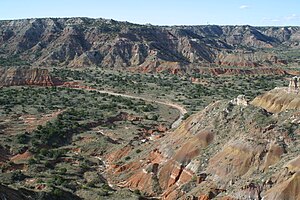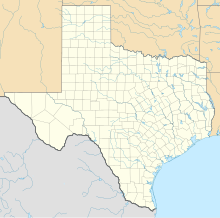| Battle of Palo Duro Canyon | |||||||
|---|---|---|---|---|---|---|---|
| Part of the Red River War, American Indian Wars | |||||||
 Palo Duro Canyon | |||||||
| |||||||
| Belligerents | |||||||
|
|
Cheyenne Comanche Kiowa | ||||||
| Commanders and leaders | |||||||
| Ranald S. Mackenzie |
Poor Buffalo Lone Wolf | ||||||
| Strength | |||||||
| 400 cavalry | 1500 warriors | ||||||
| Casualties and losses | |||||||
| 1 killed | 3 killed | ||||||
Location within Texas | |||||||
| |||||
The Battle of Palo Duro Canyon was a significant United States victory that brought about the end of the Red River War.[1][2]
Background[]
Ever since the summer of 1874 the Comanche, Cheyenne and Kiowa had sought refuge in Palo Duro Canyon in the Texas panhandle. There they had been stockpiling food and supplies for the winter. Colonel Ranald S. Mackenzie, leading the 4th U.S. Cavalry, moved up from the south intending to trap the whole force in their Palo Duro Canyon holdout. Fighting several skirmishes with Comanche warriors along the way Mackenzie reached Palo Duro in late September.[3]
The battle[]
Early in the morning of September 28, one of Mackenzie's scouts found the Indian camp and notified the colonel. Mackenzie brought the whole regiment to the edge of the canyon and planned a surprise attack. Mackenzie's troopers were unable to find a suitable path down, so instead plunged straight down the steep canyon cliffs. Mackenzie first hit Chief Lone Wolf's Kiowa camp and routed it.[2] Chiefs Poor Buffalo and Lone Wolf managed to effect some resistance but since the camps were so spread out over the canyon floor, a unified resistance was impossible. Many of the Indians fled leaving behind their possessions and headed for the open plains. Few warriors remained sniping at the soldiers but by nightfall, the canyon belonged to Mackenzie and the villages were destroyed.
Results[]
The loss of the Palo Duro camp meant the loss of the Indians' safe haven and all their winter supplies. Some horses fled with the Indians onto the plains but Mackenzie was able to capture 1,400 ponies. The horses Mackenzie did not need were slaughtered to prevent them from falling into the hands of the Indians. Casualties were light in the engagement since it had been a complete rout, but without sufficient mounts or winter supplies the tribes could not hold out over the winter and many returned to the Fort Sill reservation by November 1874.[4] Lone Wolf's Kiowas did not return until February 1875.
See also[]
- Prairie Dog Town Fork Red River
- Llano Estacado
- Caprock Escarpment
References[]
- ↑ Dillon, Richard H. (1983). North American Indian Wars
- ↑ 2.0 2.1 Thomas F. Schilz. "Palo Duro Canyon, Battle of". Handbook of Texas Online. http://www.tshaonline.org/handbook/online/articles/btp03. Retrieved 2013-02-12.
- ↑ "Named Campaigns — Indian Wars". United States Army Center of Military History. http://www.history.army.mil/html/reference/army_flag/iw.html. Retrieved December 13, 2005.
- ↑ "Red River War-Battles". Texas Beyond History. University of Texas at Austin. http://www.texasbeyondhistory.net/redriver/battles.html. Retrieved 2013-02-12.
The original article can be found at Battle of Palo Duro Canyon and the edit history here.
